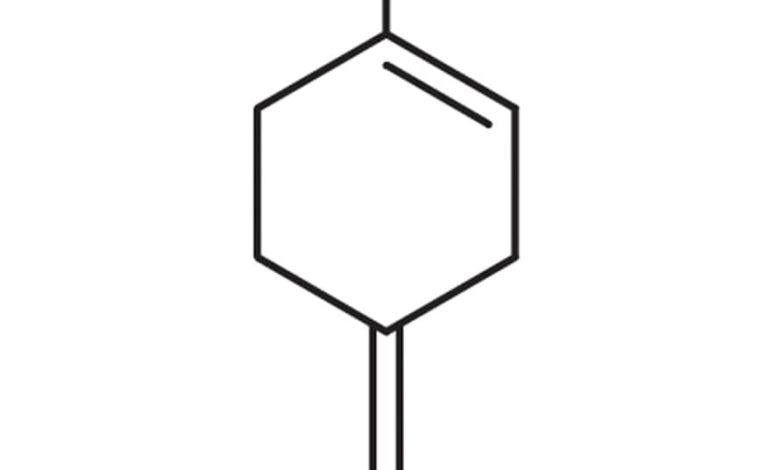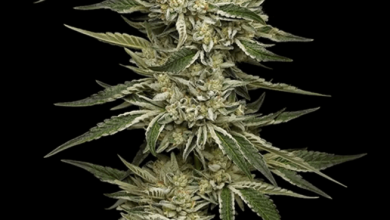Terpinolene, a key terpene in cannabis- Alchimia Grow Shop

The world of terpenes is fascinating and essential to understanding the complexity of cannabis, especially in terms of its organoleptic properties and effects. Indeed, these compounds are not only responsible for the aroma and flavor of different varieties, but they also influence the effects we experience when consuming cannabis.
One of the lesser-known but equally interesting terpenes in our favorite plant is terpinolene. Although not as common as other terpenes like myrcene or limonene, terpinolene has a unique profile that combines citrus, floral, herbal, and woody notes. In this article, we’ll explore what terpinolene is, how and where it’s synthesized, its flavor and aroma, its effects on the body and mind, and the cannabis strains found in the highest concentration.
What is terpinolene?
- Name: Terpinolene, delta-terpinene
- Formula: C10H16
- IUPAC name: 1-Methyl-4-(prop-1-en-2-yl)cyclohexa-1,3-diene
- Molar mass: 136.23 g/mol
- Boiling point: 186°C (459 K)
- Presence at room temperature: Clear, pale liquid, typically colorless or slightly yellowish
Terpinolene, also called delta-terpinene, is a naturally occurring terpene found in a wide variety of plants, including certain trees, fruits, herbs, and of course, cannabis. Unlike other terpenes that are more specific in their aromatic profile, such as limonene (citrus) or pinene (pine), terpinolene is notable for its complexity and balance. Its fragrance is an interesting mix of herbal, floral, and citrus aromas, with a slightly woody undertone, making it more subtle and nuanced than other, more intense terpenes.
This terpene is present in plants such as rosemary, tea tree, marjoram, and apples, and especially in cannabis plants with Haze genetics and other sativa varieties. While it is not the most common terpene in all cannabis plants, it does feature prominently in several popular varieties, influencing not only the aroma but also the psychoactive effects of these strains.
Synthesis of terpinolene
As with many other compounds, terpinolene is believed to be produced naturally in many plants as part of their defense mechanism, as it acts as a repellent for insects and pests. This terpene is biosynthesized through a metabolic pathway common to other cannabinoids and terpenes, where plants use precursors such as geranyl pyrophosphate (GPP) to generate a series of terpenes through the activity of various enzymes.
In a laboratory setting, the synthesis of terpinolene can be achieved using organic chemistry techniques, in particular by dehydration of certain alcohols or thermal decomposition of terpene precursors. These methods allow the creation of pure terpinolene for commercial applications, such as the formulation of cosmetic products, insect repellents, or even in aromatic products.
Thanks to these techniques, it is now possible to find synthetic terpinolene in both industrial and therapeutic products, although the use of natural terpenes, especially those derived from cannabis, remains a preferred option in many sectors due to the perception of purity and efficacy in the natural environment. However, logically, it is more common to synthesize it in the laboratory when large quantities are needed.

Flavor, aroma, and applications of terpinolene
The aroma and flavor of terpinolene is complex and certainly distinctive. As we have already mentioned, it offers a mix of herbal, floral, citrus, and woody notes. This gives it a multifaceted profile that can vary depending on the concentration and the plant it is derived from. In cannabis strains that are rich in terpinolene, this terpene contributes to a light and fresh aroma, with a hint of spice and sweetness.
Terpinolene is widely used in the cosmetic and perfume industry for its pleasant fragrance and preservative properties. Additionally, due to its antifungal, antibacterial, and antioxidant properties, it is a common ingredient in cleaning products and natural skin treatments.
It is also used in aromatherapy for its ability to promote relaxation and reduce stress. Essential oils containing terpinolene are prized for their ability to calm and balance mood, making them a popular choice in spas and wellness-related products.
Effects of Terpinolene
In terms of its effects on the body and mind, terpinolene is distinct from other terpenes that are either clearly stimulating or relaxing. Studies indicate that this terpene possesses mild sedative properties, making it an ideal compound for relieving stress and promoting sleep without being overly potent or narcotic.
Terpinolene has also shown potential as an antioxidant and antimicrobial, making it an interesting terpene to investigate for medical applications. Some studies suggest that it may have anticancer properties in certain contexts, although these findings are preliminary and require further research.
In cannabis, it has been observed that strains rich in terpinolene tend to generate a balanced effect, providing a relaxing sensation but with mental clarity. It is often combined with other terpenes, such as myrcene or limonene, to enhance these effects, offering a complete experience that is appreciated for both recreational and therapeutic uses.

Cannabis varieties rich in terpinolene
There are different cannabis genetics that are known to have a significant concentration of this terpene, often associated with the Haze family, which is famous for its euphoric and energizing effects. Among the most notable are:
- Jack Herer: A high terpinolene hybrid sativa, renowned for its clear and energizing cerebral effects, ideal for those seeking inspiration and creativity. Its fresh and herbaceous aroma is complemented by sweet and citrus notes.
- Lemon OG Candy: This multi-award-winning strain combines a strong terpinolene content with limonene, giving it a refreshing citrus aroma and an energizing experience.
- Kalimist: Another terpinolene-rich sativa, this strain has a woody and citrusy flavor profile, and produces an energetic and euphoric effect.
- Mandarin Cookies: With a sweet and citrusy profile, this strain is also rich in terpinolene and offers an excellent balance between relaxation and stimulation.
In short, terpinolene is not only a terpene notable for its aroma and flavor, but also for its ability to influence the effects of many cannabis strains. Its combination of fresh aromas and balanced effects make it a very interesting compound both in the world of perfumery and cosmetics, as well as in the field of therapeutic cannabis.
References:
- Terpenes, M. Eggersdorfer, Ullmann’s Encyclopedia of Industrial Chemistry
- A chemotaxonomic analysis of terpenoid variation in Cannabis, Hillig, Karl W
- Handbook of Environmental Fate and Exposure Data for Organic Chemicals, Philip H Howard, Edward M. Michalenko, William Meylan, Dipak K. Basu




